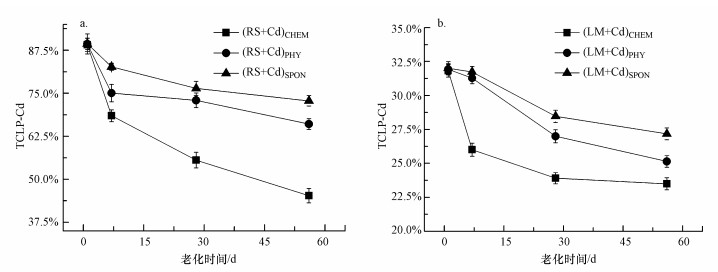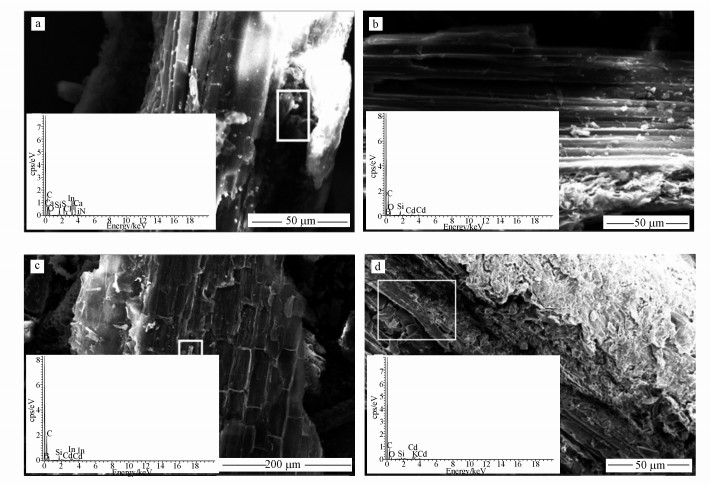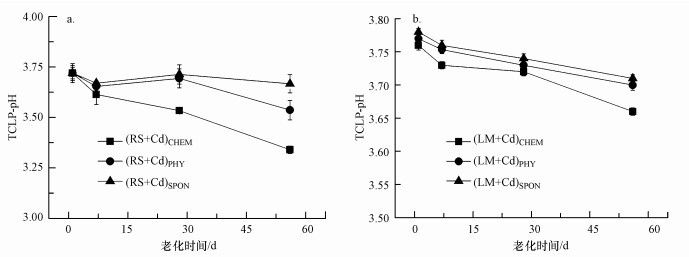 , 陈昱, 梁媛
, 陈昱, 梁媛

苏州科技大学环境科学与工程学院, 苏州 215009
收稿日期: 2017-09-14; 修回日期: 2017-10-26; 录用日期: 2017-11-12
基金项目: 国家自然科学基金(No.21507097);江苏省自然科学基金(No.BK20150288);苏州市科技支撑计划(社会发展)项目(No.SS201521)
作者简介: 高鹏(1992-), 男, E-mail:945546681@qq.com
通讯作者(责任作者): 梁媛, E-mail:liangyuan@usts.edu.cn
摘要: 环境变化是否会导致已被生物炭吸附Cd(Ⅱ)的活化?本文通过人工加速模拟老化实验研究老化作用对生物炭已吸附Cd(Ⅱ)稳定性的影响.首先进行2种生物炭对Cd(Ⅱ)的饱和吸附实验,再将饱和吸附Cd(Ⅱ)的秸秆生物炭(RS+Cd)和浮萍生物炭(LM+Cd)分别进行化学老化、物理老化和自然老化,通过TCLP(Toxicity characteristic leaching procedure)提取实验研究生物炭吸附Cd(Ⅱ)的稳定性并探究可能存在的稳定机理.结果显示,老化56 d时,RS+Cd的3种老化处理的TCLP提取态Cd(TCLP-Cd)较老化初期降低了18.58%~49.23%,而LM+Cd降低了15.10%~26.16%,老化作用提高了生物炭对Cd(Ⅱ)的吸附稳定性,稳定化效果依次为化学老化>物理老化>自然老化.进一步稳定化机理为老化作用提高了生物炭表面氧化性,增加含氧官能团,并且老化后生物炭发生破碎,有利于生物炭内部的P、Fe、Ca等元素的溶解释放,为Cd(Ⅱ)提供更多的吸附点位.浮萍生物炭对Cd(Ⅱ)的吸附较秸秆生物炭有更强的稳定性.
关键词:生物炭老化Cd (Ⅱ)稳定性
Study of aging effect on the stability of biochar initially adsorbed Cd(Ⅱ)
GAO Peng
 , CHEN Yu, LIANG Yuan
, CHEN Yu, LIANG Yuan

School of Environmental Science and Engineering, Suzhou University of Science and Technology, Suzhou 215009
Received 14 September 2017; received in revised from 26 October 2017; accepted 12 November 2017
Supported by the National Natural Science Foundation of China(No.21507097), the Natural Science Foundation of Jiangsu Province(No. BK20150288) and the Suzhou Science and Technology Support Program (No.SS201521)
Biography: GAO Peng(1992—), male, E-mail: 945546681@qq.com
*Corresponding author: LIANG Yuan, E-mail:liangyuan@usts.edu.cn
Abstract: Could the initially adsorbed Cd on biochar be remobilized when environment changes? This study explored the aging effect on the absorption stability of Cd (Ⅱ) by rice strawderived biochar (RS) and Lemna minor derived biochar (LM) via lab-based experiment. First of all, a Cd adsorption batch experiment was conducted to determined the Cd adsorption capability by RS and LM, and then a mixture of biochar and Cd (RS+Cd, LM+Cd) was aging by chemical aging (CHEM), physical ageing(PHY) and spontaneous aging(SPON). Finally, the Cd stability was evaluated by Toxicity Characteristic Leaching Procedure (TCLP), and the possible immobilization mechanism was deduced. The results showed as followed:Compared with the beginning of aging, the TCLP-Cd of RS+Cd samples with three aging methods were declined by 18.58%~49.23% after 56 days of aging, while the LM+Cd samples declined by 15.10%~26.16%. Aging further increased the stability of initially adsorbed Cd on biochar instead of re-mobilizing, with the stability effect by three aging methods followed by chemical aging > physical aging > spontaneous aging. Aging could increase the oxidability of biochar surface, as well as the amountof oxygen-containing functional groups. In addition, elements such as P, Fe and Ca could be more easily released from aged biochar because of fragmentation, which could create more adsorption points for Cd. Compared with the two biochar, the Cd stability by LM was stronger than RS.
Key words: biocharagingCd(Ⅱ)stability
1 引言(Introduction)生物炭是指生物质在无氧/限氧条件下热解得到的一种高度芳香化的含碳固态物质, 具有较强的稳定性(Lehmann et al., 2009;Beesley et al., 2011;Howat, 2011;Wang et al., 2011, Vilvanathan et al., 2017).生物炭本身比表面积大, 表面官能团丰富, 含有一定的矿物质, 通常条件下显碱性, 因而对重金属Pb、Cd、Cu、Al等有较好的吸附能力(谢超然等, 2016;潘亚男等, 2017;王震宇等, 2014;Qian et al., 2013), 可用于污染土壤中重金属的修复(Doydora et al., 2011;朱庆祥, 2011;唐行灿等, 2014;高瑞丽等, 2016).
环境变化或地球化学过程导致材料基本理化性质发生变化的过程常称为老化过程(Ghaffar et al., 2015), 生物炭材料虽然较稳定(Lehmann et al., 2011), 但外界长期的环境变化可能导致生物炭部分理化性质发生改变.如Graetz等(2003)研究发现, 风雨侵蚀会使土壤中的生物炭发生氧化, 降低其稳定性.同时, 生物炭具有一定的温度敏感性, 土壤升温会加速生物炭的矿化(Fang et al., 2014), 使其稳定性降低(Hockaday et al., 2006).生物炭材料基本理化性质的变化(Martin et al., 2012)可能导致其环境行为发生变化.自然老化过程较缓慢, 为了便于研究材料在自然界中环境行为的变化, 通常用人工加速模拟老化实验进行替代研究(Hale et al., 2011).人工加速模拟老化可提高生物炭表面的含氧量和CEC, 但生物炭的种类和污染物的类型对生物炭老化前后吸附能力的影响不同.与新鲜生物炭相比, 老化生物炭降低了对芘(Hale et al., 2011)、敌草隆、草甘膦(Zhelezova et al., 2017)、邻苯二甲酸二乙酯(Chen et al., 2008)、Cu(Guo et al., 2014)的吸附能力, 但提高了对Pb、As的吸附(Wang et al., 2017).本课题组前期研究发现, 人工加速模拟老化后的生物炭提高了对Cd(Ⅱ)的吸附量(陈昱等, 2016).
目前相关研究主要集中在生物炭老化前后材料基本理化性质的变化, 以及其对有机物、营养物质、重金属吸附能力的变化(Liang et al., 2014;徐楠楠等, 2014;Xu et al., 2016), 但对已吸附重金属的生物炭在老化过程中, 被吸附的重金属是活化还是进一步稳定化的研究较少.因此, 本研究首先开展2种生物炭对Cd(Ⅱ)的饱和吸附实验, 再对饱和吸附Cd(Ⅱ)的生物炭分别进行3种人工加速模拟老化试验, 对不同老化时间的生物炭进行TCLP提取, 评价老化作用对生物炭已吸附Cd(Ⅱ)的再迁移性的影响, 以科学评价生物炭修复Cd(Ⅱ)的长期稳定性.
2 材料和方法(Materials and methods)2.1 生物炭材料及性质本文将水稻秸秆和浮萍自然风干, 破碎, 采用慢速热解法, 在限氧、350 ℃条件下加热3 h, 制备成成水稻秸秆生物炭(Rice straw derived Biochar, RS)和浮萍生物炭(Lemna minor derived biochar, LM).两种生物炭基本理化性质见表 1.
表 1(Table 1)
| 表 1 两种生物炭理化性质 Table 1 Physical-chemical properties of biochar | ||||||||||||||||||||||||||||||
表 1 两种生物炭理化性质 Table 1 Physical-chemical properties of biochar
| ||||||||||||||||||||||||||||||
2.2 生物炭饱和吸附实验在1 L锥形瓶中分别加入2 g的水稻秸秆生物炭(RS)和浮萍生物炭(LM);然后加入pH=6、浓度为5 mmol·L-1的Cd(NO3)2溶液750 mL(0.01 mol·L-1的NaNO3溶液作为电解质), 设置5个平行样;200 r·min-1振荡24 h, 2000 r·min-1下离心3 min, 过0.45 μm滤膜, 烘干后得到饱和吸附Cd(Ⅱ)的秸秆生物炭和浮萍生物炭, 分别记为RS+Cd和LM+Cd.用火焰原子分光光度计分别测定吸附原液和吸附后溶液中Cd浓度, 计算两种生物炭的Cd饱和吸附量.
2.3 人工加速模拟老化试验对Cd(Ⅱ)饱和吸附后的2种生物炭(RS+Cd、LM+Cd)分别开展3种人工加速模拟老化(Hale et al., 2011), 老化方式分别为自然老化(Spontaneous aging, SPON)、物理老化(Physical ageing, PHY)和化学老化(Chemical ageing, CHEM).
自然老化:将RS+Cd、LM+Cd放入塑料容器中, 置于室内, 保持最大含水率的40%, 持续培养2个月, 进行自然老化, 设置3组平行样, 分别记为(RS+Cd)SPON、(LM+Cd)SPON.
物理老化:将RS+Cd、LM+Cd放入密闭容器中, 样品每天在-78 ℃条件下培养19 h, 在20 ℃条件下培养5 h, 进行物理老化, 保持最大含水率的40%, 持续2个月, 设置3组平行样, 分别记为(RS+Cd)PHY、(LM+Cd)PHY.
化学老化:将RS+Cd、LM+Cd放入密闭容器中, 持续在70 ℃条件下, 保持40%的含水率, 进行化学老化, 培养2个月, 设置3组平行样, 分别记为(RS+Cd)CHEM、(LM+Cd)CHEM.
2.4 TCLP提取实验TCLP(Toxicity characteristic leaching procedure)法被认为是一种能简便、快速、有效评价土壤重金属生态风险的方法, 常用于评价土壤重金属污染状况和修复效果评价.将不同老化时间的生物炭样品进行TCLP提取实验, 根据TCLP提取态Cd(TCLP-Cd)(式(1))评价老化作用对生物炭吸附Cd(Ⅱ)的稳定性的影响.具体方法为:准确称取0.25 g样品, 加入10 mL醋酸提取液(pH值为2.88±0.05), 200 r·min-1振荡18 h, 过0.45 μm滤膜, 测定提取液中重金属浓度.
 | (1) |
同时用pH计测定溶液的pH;通过扫描电镜(SEM-EDS)表征生物炭老化前后表面结构和元素组成变化;利用傅里叶红外(FT-IR)表征老化前后生物炭表面官能团的种类和数量的变化.
3 结果与讨论(Results and discussion)3.1 老化作用对生物炭吸附Cd(Ⅱ)稳定性的影响根据吸附实验, 秸秆生物炭、浮萍生物炭对Cd(Ⅱ)的吸附量分别为25.2和22.3 mg·g-1, 秸秆生物炭对Cd(Ⅱ)的吸附量略高于浮萍生物炭(陈昱等, 2016).
饱和吸附Cd(Ⅱ)的秸秆生物炭(RS+Cd)和浮萍生物炭(LM+Cd)在3种人工加速模拟老化过程中TTCLP-Cd随培养时间的变化如图 1所示.在老化初期, RS+Cd、LM+Cd在3种老化处理的TCLP-Cd基本相同, 即老化1 d时, (RS+Cd)CHEM、(RS+Cd)PHY、(RS+Cd)SPON的TCLP-Cd为89.10%~89.38%;(LM+Cd)CHEM、(LM+Cd)PHY、(LM+Cd)SPON的TCLP-Cd为31.82%~32.01%;浮萍生物炭对Cd(Ⅱ)的吸附稳定性显著高于秸秆生物炭.
图 1(Fig. 1)
 |
| 图 1 老化过程中TCLP提取态Cd(Ⅱ)的变化(a.RS+Cd, b.LM+Cd) Fig. 1The leachability of Cd(Ⅱ) in the TCLP extract |
随着老化时间的增加, 3种老化处理后TCLP-Cd提取率均降低.老化56 d时, (RS+Cd)CHEM、(RS+Cd)PHY和(RS+Cd)SPON的TCLP-Cd分别为45.24%、66.05%和72.78%;与老化1 d时相比, 分别下降了49.23%、26.08%和18.58%;而(LM+Cd)CHEM、(LM+Cd)PHY和(LM+Cd)SPON的TCLP-Cd分别为23.50%、25.15%和27.17%, 与老化1 d时相比, 分别下降了26.16%、21.24%和15.10%.
结果表明, 老化作用并未活化生物炭已吸附的Cd, 反而促进了生物炭表面吸附Cd(Ⅱ)的进一步稳定化.3种老化方式中, 对两种生物炭的稳定化效果均满足化学老化>物理老化>自然老化.对比两种生物炭, 虽然秸秆生物炭对Cd(Ⅱ)的吸附量略高于浮萍生物炭(RS为25.2 mg·g-1, LM为22.3 mg·g-1), 但浮萍生物炭对Cd(Ⅱ)的吸附稳定性显著高于秸秆生物炭(RS为89.10±1.93%, LM为31.82±0.45%).
3.2 老化作用促进生物炭吸附Cd(Ⅱ)进一步稳定化机理研究3.2.1 两种生物炭对Cd(Ⅱ)的吸附机制研究由于生物炭制备的原料不同, 其微观结构(Schwab, 2007; Chen et al., 2008)、物质组成也存在一定的差异(许妍哲, 2015).对比两种生物炭的基本理化性质(表 1)发现, 秸秆生物炭具有更高的碱性和更大的比表面积, 由扫描电镜(图 2)可以看出, 秸秆生物炭有整齐的条状孔道结构, 秸秆生物炭主要通过表面吸附和静电作用吸附Cd(Ⅱ)(Uchimiya et al., 2010, 夏广洁等, 2014), 但静电吸附和表面吸附不稳定, 容易受到环境中pH、Eh等因素的影响.而浮萍生物炭表面呈面状有褶皱突起(图 3), 孔道结构不明显, 比表面积较秸秆生物炭小27.3%, 但浮萍生物炭含有更多可溶性P、Fe、Mn、Ca、Mg等矿物质和较高的CEC(表 1, 图 3 EDS), 可与Cd(Ⅱ)发生化学吸附或沉淀机制;例如, 生物炭中可溶性P可与Cd(Ⅱ)发生络合作用, 产生无定形态P-Cd物质(王期凯等, 2015);Fe/Mn也可以与Cd(Ⅱ)形成铁锰氧化态络合物(梁媛等, 2013), 这些生成物较稳定;因此, LM+Cd处理的TCLP-Cd显著小于RS+Cd处理, 浮萍生物炭对Cd(Ⅱ)的吸附较秸秆生物炭更稳定.
图 2(Fig. 2)
 |
| 图 2 秸秆生物炭3种老化前后SEM和EDS图谱分析(a.RS+Cd+1d;b.RS+Cd+CHEM+56d;c.RS+Cd+PHY+56d;d.RS+Cd +SPON+56d) Fig. 2SEM and EDS spectrograms of RS with three aging methods |
图 3(Fig. 3)
 |
| 图 3 浮萍生物炭3种老化前后SEM和EDS图谱(a.LM+Cd+1d;b.LM + Cd + CHEM+56d;c.LM + Cd +PHY+56d;d.LM + Cd +SPON+56d) Fig. 3SEM and EDS spectrograms of LM with three aging methods |
3.2.2 老化作用对两种生物炭吸附Cd(Ⅱ)稳定性的影响秸秆生物炭孔道结构明显, 有整齐的条状孔道结构(图 2).物理老化由于剧烈的冻融交替作用可使生物炭表面断裂, 破碎化程度增大, 可为Cd(Ⅱ)提供新的吸附位点.由EDS图谱可看出, 老化后的秸秆生物炭表面仍以C、O为主, 并含有一定的Si元素, 基本无其他物质, 进一步验证秸秆生物炭对Cd(Ⅱ)的吸附主要为表面吸附(吴成等, 2007).有研究显示, Si元素可与Cd(Ⅱ)发生反应, 形成CdSiO3和/或CdAl2(SiO4)(Qian et al., 2013; 2014), 提高了生物炭与Cd (Ⅱ)结合的稳定性.
表 2为秸秆生物炭老化前后表面C、O及O/C比值统计结果.与生物炭原样相比, 化学老化和物理老化使O/C从原样的36.07%分别提高到54.69%和45.13%.秸秆生物炭表面O/C的提高表明, 化学老化和物理老化作用提高了生物炭表面的氧化性(Kim et al., 2017), 含氧官能团增加, 有利于Cd(Ⅱ)的进一步吸附和稳定(李力等, 2012).
表 2(Table 2)
| 表 2 秸秆生物炭3种老化前后表面C和O元素分析 Table 2 The surface C and O of RS with three aging methods | ||||||||||||||||||||
表 2 秸秆生物炭3种老化前后表面C和O元素分析 Table 2 The surface C and O of RS with three aging methods
| ||||||||||||||||||||
浮萍生物炭呈面状, 表面有褶皱突起, 孔道结构不明显(图 3).由EDS图谱可看出, 3种老化后浮萍生物炭在Cd(Ⅱ)吸附点位附近同时存较多的P、Al、Mg、Fe、Ca等元素, 说明Cd(Ⅱ)与P、Al、Mg、Fe、Ca等元素可能发生共沉淀或化学吸附作用.在老化作用下, 生物炭表面可能发生破裂, 有利于生物炭内部的P、Fe、Al、Ca等物质的进一步溶解, 并继续与Cd(Ⅱ)发生共沉淀或络合作用, 进一步促进生物炭吸附Cd(Ⅱ)的稳定性(陈建清等, 2016, 田秀美等, 2012).
表 3为浮萍生物炭老化前后C、O及O/C比值的统计结果.与生物炭原样相比, 化学老化和物理老化使浮萍生物炭O/C从原样的49.00%分别提高到73.38%和69.46%, 与秸秆生物炭变化趋势基本一致, 说明在化学和物理老化作用下生物炭表面官能团增加, 为Cd(Ⅱ)的吸附提供更多的吸附位点, 提高被生物炭吸附Cd(Ⅱ)的稳定性.
表 3(Table 3)
| 表 3 浮萍生物炭3种老化前后表面C和O元素分析 Table 3 The surface C and O of LM with three aging methods | ||||||||||||||||||||
表 3 浮萍生物炭3种老化前后表面C和O元素分析 Table 3 The surface C and O of LM with three aging methods
| ||||||||||||||||||||
3.2.3 不同老化前后生物炭官能团变化两种生物炭老化前后的傅里叶红外光谱分析(图 4)能较直观地表征生物炭表面官能团种类和数量变化;羟基和羧酸根基团可能对Cd(Ⅱ)吸附稳定发挥主要作用(Moyo et al., 2016).秸秆较浮萍含有更多的木质素, 木质素本身含有较多酚类且不易被氧化(Zhang et al., 2011), 因此, 秸秆生物炭在3380 cm-1左右的—OH振动峰(Uchimiya, 2011)和振幅均高于浮萍生物炭, 化学老化作用(氧化)后, 1650 cm-1左右—COOH和C=O振动峰的增幅均低于浮萍生物炭.
图 4(Fig. 4)
 |
| 图 4 两种生物炭3种老化前后FT-IR图谱分析(a.RS+Cd+, b.LM+Cd) Fig. 4The FTIR spectrograms of biochar with three aging method |
在化学老化作用下, 两种生物炭在3390 cm-1左右的—OH振动峰宽度和振幅均明显降低, 而在1650 cm-1左右处振动峰宽增加, 并且出现双峰, 说明—COOH和C=O数量增加, 是羧化过程(Guo et al., 2014), 与EDS中O/C增加的结论一致;并且, 秸秆生物炭化学老化后在1103 cm-1处Si—O振动峰振幅明显增加, Si—O键的增加可为Cd(Ⅱ)提供更多的吸附位点, 促进被生物炭吸附Cd(Ⅱ)的进一步稳定(林宁等, 2016, Martin et al., 2012);在物理老化作用下, 两种生物炭在1650 cm-1左右的—COOH和C=O振动峰和3380 cm-1左右的—OH振动峰振幅均有所增加, 羧基和羟基增加, 有利于被生物炭吸附Cd(Ⅱ)的稳定性的提高;自然老化由于作用较温和, 老化前后两种生物炭官能团种类和数量基本无变化.
3.2.4 老化作用对生物炭TCLP-pH的影响图 5为RS+Cd和LM+Cd在3种人工加速模拟老化过程中, TCLP提取液的pH(TCLP-pH)随老化时间的变化关系.老化初期(1d), 秸秆生物炭和浮萍生物炭的TCLP-pH分别约为3.72和3.77, 3种老化处理的pH基本相同.随着培养时间的增加, 两种生物炭TCLP-pH基本呈现下降趋势.老化56 d时, (RS+Cd)CHEM、(RS+Cd)PHY、和(RS+Cd)SPON的pH分别为3.34、3.53和3.67, 与老化1 d时相比分别下降了5.02%、0.71%和0.18%;(LM+Cd)CHEM、(LM+Cd)PHY和(LM+Cd)SPON的pH分别为3.66、3.70和3.71, 与老化1 d时相比分别下降了2.66%、1.86%和1.85%.3种老化处理相比, pH下降趋势满足:化学老化>物理老化>自然老化.
图 5(Fig. 5)
 |
| 图 5 老化过程中TCLP-pH变化(a.RS+Cd, b.LM+Cd) Fig. 5The pH in the TCLP extract during aging |
两种生物炭的TCLP-pH和Cd(Ⅱ)的相关关系如表 4所示.老化促进生物炭表面形成更多的酸性含氧官能团(如—COOH、C=O), 使pH降低.pH降低有利于生物炭中Fe、Mn、Ca等元素的进一步溶解释放, 可与Cd(Ⅱ)进一步发生吸附、沉淀等作用(王震宇等, 2014;郭文娟等, 2013), 促进Cd(Ⅱ)的进一步稳定化.
表 4(Table 4)
| 表 4 TCLP-Cd与TCLP-pH的相关关系 Table 4 The correlations coefficient (r) of heavy meantal and pH | ||||||||||||||
表 4 TCLP-Cd与TCLP-pH的相关关系 Table 4 The correlations coefficient (r) of heavy meantal and pH
| ||||||||||||||
4 结论(Conclusions)1) 老化作用并未活化生物炭已吸附的Cd(Ⅱ), 反而促进生物炭表面已吸附Cd(Ⅱ)的进一步稳定化, 3种老化对Cd(Ⅱ)进一步稳定化效果满足:化学老化>物理老化>自然老化.
2) 老化作用提高了两种生物炭吸附Cd(Ⅱ)的稳定性, 主要是通过提高破碎化程度, 增加生物炭表面的官能团数量和种类, 以及生物炭内部的P、Fe、Ca等物质的进一步溶出而与生物炭表面的Cd(Ⅱ)发生吸附、沉淀等机制实现的, 老化作用基本未改变生物炭对Cd(Ⅱ)的吸附作用机制.
3) 秸秆生物炭对Cd(Ⅱ)的吸附主要为表面吸附, 而浮萍生物炭对Cd(Ⅱ)的吸附主要为化学吸附和沉淀机制.浮萍生物炭对Cd(Ⅱ)的吸附更具有稳定性.
参考文献
| Beesley L, Marmiroli M. 2011. The immobilisation and retention of soluble arsenic, cadmium and zinc by biochar[J]. Environmental Pollution, 159(2): 474–480.DOI:10.1016/j.envpol.2010.10.016 |
| ChenB L, ZhouD D, ZhuL Z, 等. 2008. Sorption characteristics and mechanisms of organic contaminant to carbonaceous biosorbents in aqueous solution[J]. 中国科学:化学, 2008, 51(5): 464–472. |
| 陈建清, 郭栋, 陈德, 等. 2016. 生物质炭、有机肥和钙镁磷肥对三七(Panax Notoginseng)Cd含量的影响[J]. 农业环境科学学报, 2016, 35(10): 1909–1916.DOI:10.11654/jaes.2016-0353 |
| 陈昱, 梁媛, 郑章琪, 等. 2016. 老化作用对水稻秸秆生物炭吸附Cd(Ⅱ)能力的影响[J]. 环境化学, 2016, 35(11): 2337–2343.DOI:10.7524/j.issn.0254-6108.2016.11.2016031601 |
| Doydora S A, Cabrera M L, Das K C, et al. 2011. Release of nitrogen and phosphorus from poultry litter amended with acidified biochar[J]. International Journal of Environmental Research & Public Health, 8(5): 1491–1502. |
| Fang Y, Singh B P, Singh B. 2014. Temperature sensitivity of biochar and native carbon mineralisation in biochar-amended soils[J]. Agriculture Ecosystems & Environment, 191: 158–167. |
| 高瑞丽, 朱俊, 汤帆, 等. 2016. 水稻秸秆生物炭对镉、铅复合污染土壤中重金属形态转化的短期影响[J]. 环境科学学报, 2016, 36(1): 251–256. |
| Ghaffar A, Ghosh S, Li F, et al. 2015. Effect of biochar aging on surface characteristics and adsorption behavior of dialkyl phthalates[J]. Environmental Pollution, 206: 502–509.DOI:10.1016/j.envpol.2015.08.001 |
| Graetz R E, Skjemstad J O. 2003. The charcoal sink of biomass burning on the Australian continent[J]. CSIRO Atmospheric Research Technical Paper, 64: 1–69. |
| 郭文娟, 梁学峰, 林大松, 等. 2013. 土壤重金属钝化修复剂生物炭对镉的吸附特性研究[J]. 环境科学, 2013, 34(9): 3716–3721. |
| Guo Y, Tang W, Wu J, et al. 2014. Mechanism of Cu(Ⅱ) adsorption inhibition on biochar by its aging process[J]. J Environ Sci, 26(10): 2123–2130.DOI:10.1016/j.jes.2014.08.012 |
| Hale S E, Hanley K, Lehmann J, et al. 2011. Effects of chemical, biological, and physical aging as well as soil addition on the sorption of pyrene to activated carbon and biochar[J]. Environmental Science & Technology, 45(24): 10445–10453. |
| Hockaday W C, Grannas A M, Kim S, et al. 2006. Direct molecular evidence for the degradation and mobility of black carbon in soils from ultrahigh-resolution mass spectral analysis of dissolved organic matter from a fire-impacted forest soil[J]. Organic Geochemistry, 37(4): 501–510.DOI:10.1016/j.orggeochem.2005.11.003 |
| Howat P. 2011. A review of biochars' potential role in the remediation, revegetation and restoration of contaminated soils[J]. Environmental Pollution, 159(12): 3269–3282.DOI:10.1016/j.envpol.2011.07.023 |
| Kim H, Kim J, Kim M, et al. 2017. Sorption of sulfathiazole in the soil treated with giant Miscanthus-derived biochar:effect of biochar pyrolysis temperature, soil pH, and aging period[J]. Environmental Science & Pollution Research. |
| Lehmann J D, Joseph S. 2009. Biochar for environmental management:science and technology[J]. Science and Technology, Earthscan, 25(1): 15801–15811. |
| Lehmann J, Rillig M C, Thies J, et al. 2011. Biochar effects on soil biota-A review[J]. Soil Biology & Biochemistry, 43(9): 1812–1836. |
| 李力, 陆宇超, 刘娅, 等. 2012. 玉米秸秆生物炭对Cd(Ⅱ)的吸附机理研究[J]. 农业环境科学学报, 2012, 31(11): 2277–2283. |
| 梁媛, 李飞跃, 杨帆, 等. 2013. 含磷材料及生物炭对复合重金属污染土壤修复效果与修复机理[J]. 农业环境科学学报, 2013, 32(12): 2377–2383.DOI:10.11654/jaes.2013.12.010 |
| Liang Y, Cao X, Zhao L, et al. 2014. Biochar-and phosphate-induced immobilization of heavy metals in contaminated soil and water:implication on simultaneous remediation of contaminated soil and groundwater[J]. Environmental Science & Pollution Research, 21(6): 4665–4674. |
| 林宁, 张晗, 贾珍珍, 等. 2016. 不同生物质来源生物炭对Pb(Ⅱ)的吸附特性[J]. 农业环境科学学报, 2016, 35(5): 992–998.DOI:10.11654/jaes.2016.05.025 |
| Martin S M, Kookana R S, Van Z L, et al. 2012. Marked changes in herbicide sorption-desorption upon ageing of biochars in soil[J]. Journal of Hazardous Materials, 231-232(6): 70–78. |
| Moyo M, Lindiwe S T, Sebata E, et al. 2016. Equilibrium, kinetic, and thermodynamic studies on biosorption of Cd(Ⅱ) from aqueous solution by biochar[J]. Research on Chemical Intermediates, 42(2): 1349–1362.DOI:10.1007/s11164-015-2089-z |
| 潘亚男, 陈灿, 王欣, 等. 2017. 凤眼莲源生物炭对土壤As、Hg、Cd溶出特性与化学形态的影响[J]. 环境科学学报, 2017, 37(6): 2342–2350. |
| Qian L, Chen B. 2013. Dual role of biochars as adsorbents for aluminum:The effects of oxygen-containing organic components and the scattering of silicate particles[J]. Environmental Science & Technology, 47(15): 8759–8768. |
| Qian L, Chen B. 2014. Interactions of aluminum with biochars and oxidized biochars:implications for the biochar aging process[J]. Journal of Agricultural & Food Chemistry, 62(2): 373–80. |
| Schwab M. The ecological society of America[J]. Science, 58(1505): 357. |
| 唐行灿, 张民. 2014. 生物炭修复污染土壤的研究进展[J]. 环境科学导刊, 2014, 33(1): 17–26. |
| 田秀美. 2012. 磷和腐殖酸对生物炭去除水中Cr(Ⅵ)的影响研究[D]. 重庆: 重庆大学 |
| Uchimiya M, Llma I M, Klasson K T. 2010. Immobilization of heavy metal ions (Cu(Ⅱ), Cd(Ⅱ), Ni(Ⅱ), and Pb(Ⅱ)) by broiler litter-derived biochars in water and soil[J]. Journal of Agricultural & Food Chemistry, 58(9): 5538–5544. |
| Uchimiya S. 2011. Influence of pyrolysis temperature on biochar property and function as heavy metal sorbent in soil[J]. Journal of Agricultural & Food Chemistry, 59(6): 2501–2510. |
| Vilvanathan S, Shanthakumar S. 2017. Modeling of fixed-bed column studies for removal of cobalt ions from aqueous solution using Chrysanthemum indicum[J]. Research on Chemical Intermediates, 43(1): 1–15.DOI:10.1007/s11164-016-2601-0 |
| Wang H, Feng M, Zhou F, et al. 2017. Effects of atmospheric ageing under different temperatures on surface properties of sludge-derived biochar and metal/metalloid stabilization[J]. Chemosphere, 184: 176–184.DOI:10.1016/j.chemosphere.2017.05.175 |
| Wang X S, Miao H H, He W, et al. 2011. Competitive adsorption of Pb(Ⅱ), Cu(Ⅱ), and Cd(Ⅱ) ions on wheat-residue derived black carbon[J]. Journal of Chemical & Engineering Data, 56(3): 444–449. |
| 王期凯, 郭文娟, 孙国红, 等. 2015. 生物炭与肥料复配对土壤重金属镉污染钝化修复效应[J]. 农业资源与环境学报, 2015, 32(6): 583–589. |
| 王震宇, 刘国成, MonicaXing, 等. 2014. 不同热解温度生物炭对Cd(Ⅱ)的吸附特性[J]. 环境科学, 2014, 35(12): 4735–4744. |
| 吴成, 张晓丽, 李关宾. 2007. 黑碳吸附汞砷铅镉离子的研究[J]. 农业环境科学学报, 2007, 26(2): 770–774. |
| 夏广洁, 宋萍, 邱宇平. 2014. 牛粪源和木源生物炭对Pb(Ⅱ)和Cd(Ⅱ)的吸附机理研究[J]. 农业环境科学学报, 2014, 33(3): 569–575.DOI:10.11654/jaes.2014.03.025 |
| 谢超然, 王兆炜, 朱俊民, 等. 2016. 核桃青皮生物炭对重金属铅、铜的吸附特性研究[J]. 环境科学学报, 2016, 36(4): 1190–1198. |
| 徐楠楠, 林大松, 徐应明, 等. 2014. 玉米秸秆生物炭对Cd2+的吸附特性及影响因素[J]. 农业环境科学学报, 2014, 33(5): 958–964.DOI:10.11654/jaes.2014.05.019 |
| Xu P, Sun C X, Ye X Z, et al. 2007. The effect of biochar and crop straws on heavy metal bioavailability and plant accumulation in a Cd and Pb polluted soil[J]. Ecotoxicology & Environmental Safety, 132: 94–100. |
| 许妍哲, 方战强. 2015. 生物炭修复土壤重金属的研究进展[J]. 环境工程, 2015, 33(2): 156–159.DOI:10.11835/j.issn.1005-2909.2015.02.037 |
| 张庆沛, 李冰, 王昌全, 等. 2016. 秸秆还田配施无机改良剂对稻田土壤镉赋存形态及生物有效性的影响[J]. 农业环境科学学报, 2016, 35(12): 2345–2352.DOI:10.11654/jaes.2016-0553 |
| Zhang G, Zhang Q, Sun K, et al. 2011. Sorption of simazine to corn straw biochars prepared at different pyrolytic temperatures[J]. Environmental Pollution, 159(10): 2594–2601.DOI:10.1016/j.envpol.2011.06.012 |
| Zhelezova A, Cederlund H, Stenstr?m J. 2017. Effect of biochar amendment and ageing on adsorption and degradation of two herbicides[J]. Water Air & Soil Pollution, 228(6): 216–229. |
| 朱庆祥. 2011. 生物炭对Pb、Cd污染土壤的修复试验研究[D]. 重庆: 重庆大学 |
